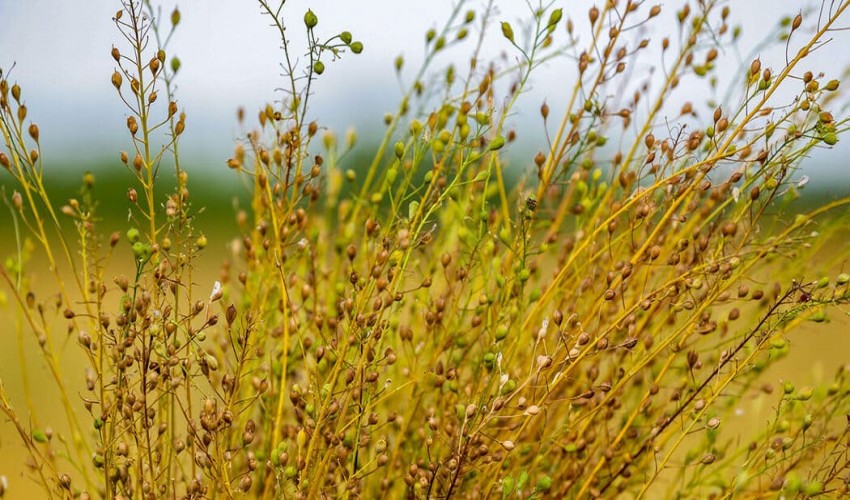Microbiology
8
Ancient grain with aviation biofuel potential may have Armenian roots, according to a new study
- Rating
- cultivating camelina
- discover camelina
- camelina seeds
- camelina producers
Ancient oilseed crop Camelina, often known as "false flax" or "Gold-of-Pleasure," is being used to produce sustainable, low-input biofuels. Camelina's origins and usage are being revealed by researchers at Washington University in St. Louis, which might help guide future judgments on its potential as a biofuel source for a greener aviation sector.
Jordan Brock, a biologist at Washington University, went on multiple field trips to gather wild camelina during his tenure as a graduate student, including a National Geographic Explorers trip to Ukraine. Brock was particularly impressed by the fact that rural Ukrainians were still cultivating camelina, a crop that had all but disappeared in the rest of Europe.
Melissa Ritchey, a doctoral student in anthropology at Washington University, and Kenneth M. Olsen, professor of biology at the School of Arts & Sciences, co-authored a new study in the American Journal of Botany that suggests camelina may have been a more important and widespread crop than previously thought.
Ritchey said that by combining archaeological and genetic information, they were able to acquire a better knowledge of agricultural domestication's history as well as the reductions and rises in the number of crops that have been used throughout time. According to the findings of this study, some 6,000 to 8,000 years ago, people in the Caucasus area near what is now Armenia domesticated camelina.
It's important to remember that this crop's wild ancestor, Camelina microcarpa, has a wide range of genetic variation across Western Asia and the Caucasus area, experts say.
One of the world's oldest crops
Many aspects of Camelina's lengthy and illustrious European oilseed crop history remain a mystery.
Camelina seeds were stored away from flax seeds in storage at early Iron Age archaeological sites, suggesting that they were grown independently. After the Roman Empire, Camelina remained popular until at least the early 20th century. camelina was abandoned by most Western European nations in 1930s and 1940s, although crop experts and farmers in Russia and Sweden continue to grow camelina. Researchers at Washington University employed genotyping-by-sequencing to evaluate population structure within the crop species and its link to populations of its wild progenitor in 185 accessions of Camelina sativa and its wild relatives. Additionally, they searched the archaeological literature to locate camelina-related sites and to determine the frequency of camelina use in Europe, the Middle East, and Western Asia.
According to Ritchey, "the great bulk of evidence in archaeobotany originates from burnt plant remnants." Even though camelina has a high oil content, it is not charred but rather destroyed when it comes into touch with a fire. In spite of this, I was able to locate a great deal of data, which helped us get the answers we were seeking.
There were also camelina "cakes" unearthed at Viking and Iron Age sites throughout northern Europe, she added.
Camelina records from Gordion, a UNESCO World Heritage Site in Turkey, and Kumtepe, the earliest permanent habitation in the Troas area in northeastern Anatolia, where Troy was subsequently established were also discovered by Ritchey. It has long been hypothesised by archaeologists that camelina was domesticated in Armenian areas, while plant geneticists have posited contradictory theories about the plant's beginnings as a food crop.
On the basis of our research findings, we have been able to evaluate these ideas and come to a firmer agreement on the first domesticated appearances in Armenia."
Rekindled interest in biofuels as a source of energy A surge in molecular research into camelina and ways to enhance it has been sparked by renewed interest in the plant. Because of the short growing season and minimal input needs, camelina might be a beneficial crop in locations where there are few other options. Because Camelina can be cultivated in poor soils, it may be possible to use land that is otherwise unusable to grow it.
Breeding or genetic manipulation may be used to improve these characteristics. Modern varieties of the crop, on the other hand, lack variation, making this proposition more difficult. False flax and Gold-of-Pleasure are other names for Camelina sativa. Washington University in St. Louis research suggests that camelina may have been a more significant and widespread crop than previously imagined. Photograph by Shutterstock
Breeders seeking for genetic variety and agricultural qualities (increased yield, stronger disease resistance, drought tolerance, etc.) to employ for breeding superior camelina cultivars have difficulties due to the lack of genetic diversity in current cultivars, Brock stated.
Because of the new wild variety discovered in Georgia and Armenia, Brock believes that understanding the history of camelina domestication is a significant and relevant finding. A remedy to the crop's lack of genetic variety may be found here.
Farmers interested in conventional food usage as well as those looking to extend camelina's use as a biofuels feedstock stand to gain significantly.
Brock, a postdoctoral research associate at Michigan State University funded by the National Science Foundation (NSF), believes that the usage of camelina-derived jet fuel as an aviation biofuel will be the largest game-changer. It has previously been tested by the U.S. Air Force and in commercial planes, and the results indicate a significant reduction in emissions.
According to him, "Camelina oil mixes have shown to be feasible." Field output and crop yield will be the next challenge.
The ages have a wide range of applications.
There is still a lot of potential for camelina to re-emerge as an edible oil for contemporary consumers, despite the present focus on camelina as a biofuel source,
While doing field research, Brock was especially struck by his experiences with camelina producers. Brock added that seeing how camelina seeds are processed in Ukraine into oil for salads or bread dipping, and a protein-rich seed meal for animal feed, was a "critical milestone" for him. In Europe, I was surprised to discover that camelina was still being utilised in traditional ways, and this made me realise the necessity of learning more about this crop and its history. A common objective of genetics and archaeology, Ritchey said, is to trace historical populations of plants, animals, or even humans back to their ancestors. "To address these concerns, we are progressively collaborating with our data, research capabilities, and interpretations. If we can answer these essential questions regarding human evolution, as well as our connections with other living things, like plants, it's a great feeling.
Leave a Reply
Your email address will not be published. Required fields are marked *


